Nội dung bài viết
As the future of global transportation, electric vehicles not only require a modern and efficient charging station infrastructure, but safety factors also need to be emphasized. Besides overload, short circuit, electric leakage, lightning strike is one of the dangerous incidents that can paralyze the charging station system, affecting both electric vehicles and people. To learn details about comprehensive lightning protection solutions for electric vehicle charging stations, you can follow the article below.
Why are electric vehicle charging stations often affected by lightning?
A report by the Insurance Institute for Business & Home Safety said that each year in the United States there are about 25 million lightning strikes, causing damage from 650 million to 1 billion USD. Among them, power lines, high-rise buildings and outdoor charging stations are the top targets of lightning.
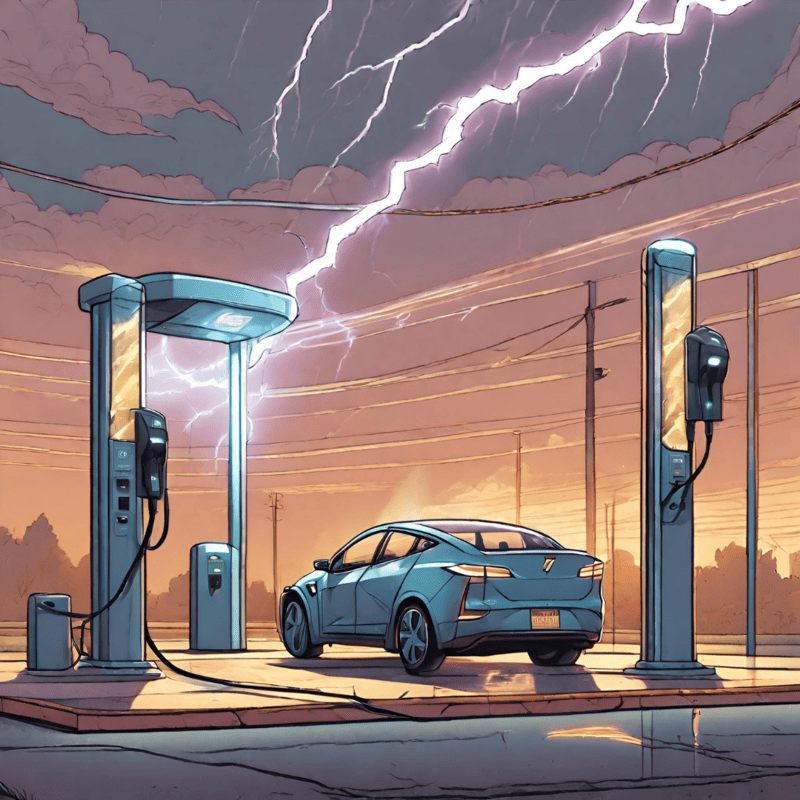
The reason is that most charging stations are often located in open locations such as highways, highways, parking areas, near electric poles or transformer stations to facilitate wire connection, plus the direction of the power cable connecting the station to the power grid causes the charging station to always be exposed to the impact of direct or transmitted lightning strikes.
In addition, the charging station itself contains many sensitive electronic devices such as Rectifiers, Control Circuits, Cooling Systems, Communication Signal Blocks… so just one induced overvoltage pulse from nearby lightning can seriously affect the control microchips inside the charging station.
Impact of lightning on electric vehicle charging stations
Electric vehicle charging stations, especially private wall-mounted chargers, are designed to withstand overvoltage thresholds of 4-6kV (Overvoltage Types III and IV), especially electric vehicles are rated at 2.5kV (Overvoltage Type II). Meanwhile, lightning strikes create a sudden overvoltage phenomenon that can paralyze the entire charging station system and endanger human life.
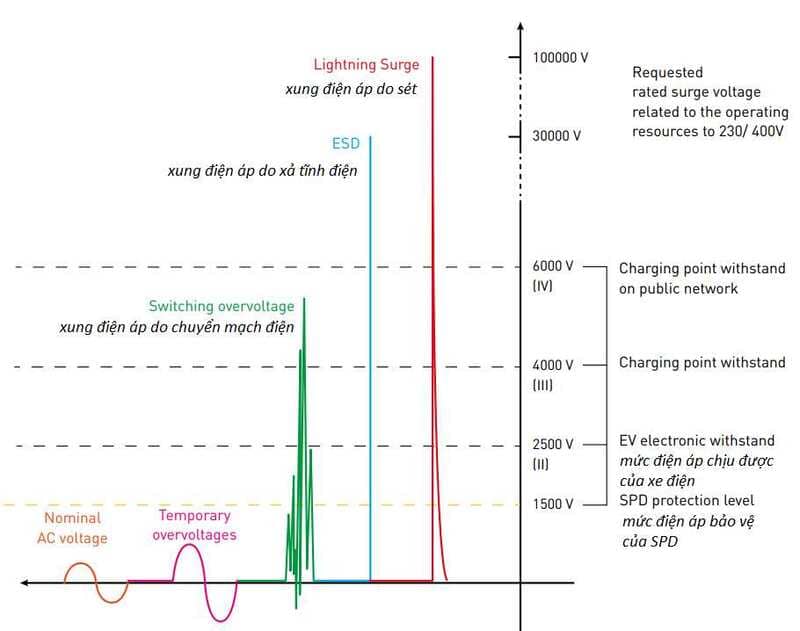
Below are the effects of lightning on electric vehicle charging stations:
| Impact | Detailed description |
| Damage to expensive electronic equipment | Lightning strikes, whether direct or transmitted, create high voltage pulses that exceed the tolerance level of the devices in the charging station. This can immediately burn out or damage all sensitive electronic components inside the charging station such as control circuits, rectifiers, communication modems, causing service interruption and increasing expensive repair/replacement costs. |
| Harmful to electric vehicles while charging | Electric vehicles during charging create an electrically conductive link between the station and the battery. At this time, the overvoltage pulse from lightning easily transmits from the station to the vehicle via the charging cable, causing damage to the battery and expensive components of the vehicle: Battery Management Unit (BMS), battery, computer system… |
| Risk of fire and explosion | In some cases, a direct lightning strike to the charging station can cause an electrical short, a fire or explosion at the charging station, and even the risk of fire spreading to neighboring buildings and vehicles parked in the station. |
| Dangerous for humans | Lightning strikes or severe overvoltages create dangerous step voltages that can endanger the lives of users or operators in the charging station area. |
| Damage to power and signal systems | Lightning strikes not only affect the main circuit but can also spread through the signal lines in the charging station, causing damage to many other systems such as measurement, control systems, internet,… causing the charging station to lose the ability to communicate and receive commands. |
Electric vehicle charging stations only need to install lightning rods to protect against lightning?
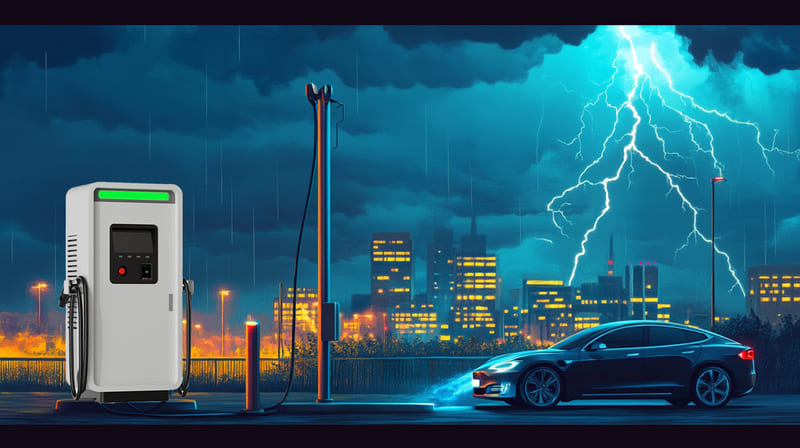
Many people believe that charging stations near high-rise buildings/commercial centers can take advantage of the lightning rods there to protect against lightning, or charging stations in deserted areas only need to install independent lightning rods to provide enough protection. This concept is completely wrong because lightning rods alone are not enough to fully protect the charging station infrastructure from the impact of lightning.
Lightning rods often have the main task of protecting the physical structure of buildings and objects in high positions from direct lightning strikes, by safely conducting high-intensity electric current to the ground, through a standard grounding system. However, lightning rods do not have the effect of preventing sudden overvoltage caused by lightning strikes at neighboring locations and spreading back into the main structure.
In fact, very few electric vehicle charging stations are subject to direct lightning strikes. While the biggest danger to sensitive and expensive electronic components inside the charging station comes from overvoltage spread by lightning striking nearby power lines or ground, creating a huge electromagnetic pulse that propagates back to the charging station through the wiring system. Therefore, electric vehicle charging stations need a special lightning protection system to prevent any potential dangers from voltage spikes.
Lightning protection requirements for charging stations according to international standards
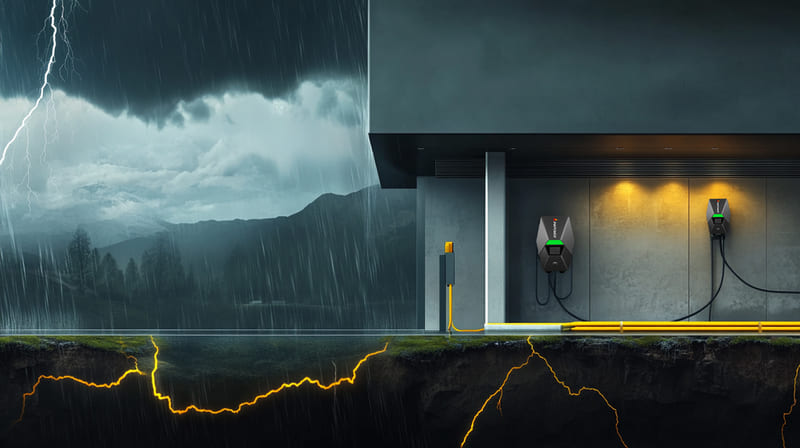
An effective and safe lightning protection system for charging stations needs to meet the following international and national standards:
- IEC 61851-1: The general standard applies to charging of electric vehicles with voltages up to 1000VAC or 1500VDC, accompanied by guidance on types of overvoltage applied to charging stations and electric vehicles.
- IEC 60364-7-722: Standards for power supply for electric vehicles on low-voltage grids, including requirements for surge protection for charging stations in general.
- IEC 60364-4-443: Standard “Protection against propagating overvoltage” to determine the importance of SPD devices for low voltage power systems.
- IEC 60364-5-534: Standards for selecting and installing SPD for alternating current, including main parameters, protection level, discharge current…
- ISO 17409: The standard defines regulations that ensure the safety of electric vehicles (Class II Overvoltage rating).
- TCVN 9385:2012: Lightning protection standards for construction works, applied to direct lightning protection systems. Although there are no specific regulations on lightning protection for charging stations, this is still a general national standard on lightning protection for buildings.
Comprehensive lightning protection solution for charging stations
To prevent all risks from lightning and sudden overvoltage, large charging stations, especially DC fast charging stations, need to be fully equipped with lightning protection systems including: direct lightning protection, surge protection and grounding system.
Lightning Protection System (LPS)
By creating a protective zone around the charging station, the LPS system is capable of capturing and safely conducting lightning current to ground – in case the charging station is directly struck by lightning. Therefore, LPS installation must be performed by experts based on IEC 62305 and TCVN 9385:2012 standards, usually at the highest point of the station or on a metal roof. In addition, to completely prevent the impact of direct lightning strikes, experts recommend that investors can equip additional Type 1 surge protectors on AC lines with lightning arrester systems.

A standard LPS system usually includes 3 main components:
- Lightning: Usually a lightning rod or lightning wire. Based on the protection level of each type of lightning rod, engineers will calculate the safe area in the charging station.
- Lightning conductivity: Consists of copper or galvanized steel conductors with large cross-sections, responsible for conducting lightning current from the lightning rod to the ground. This wiring system must ensure the shortest path to avoid creating sparks.
- Grounding: Consists of a network of copper grounding rods, connected together by grounding wires. The grounding part of the lightning protection system must be voltage balanced with the grounding system of the power grid, as well as the lightning protection system. The goal is to reduce the grounding resistance to ≤10Ω so that the lightning current is quickly dissipated to the ground.
Surge Protection Devices (SPD)
This is the most important measure to eliminate the risk of voltage spikes that can cause damage to electronic components inside the charging station.
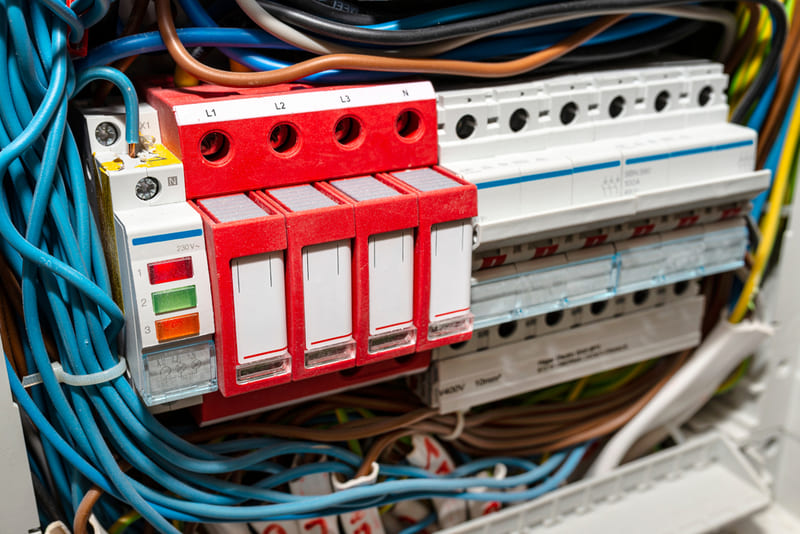
SPD should be installed in many locations and levels as follows:
By charging station level
- Level 1 AC charging station: Usually personal chargers, using regular electrical outlets like household electrical equipment. UL 1449 standard stipulates that SPDs need to be installed at the main input electrical panel or an additional Type 2 SPD can be installed at the electric vehicle charger input.
- Level 2 AC charging station: Use a power source of 240VAC or higher (North American standard), suitable for public charging stations. Level 2 charging stations need to be equipped with SPDs at the sub-distribution panel and charger inlet.
- Level 3 DC charging station: This type of charging station is typically connected to the grid or a battery system that stores renewable energy. Therefore, the surge protection system should be installed at the DC power cabinet and the input source of the vehicle charger.
According to the protection class
- At the main power cabinet: Priority is given to installing SPD Type 1+2 combined for the power supply cabinet to the charging station and Type 1 lightning surge protection to protect the signal lines of the control circuit and measurement system.
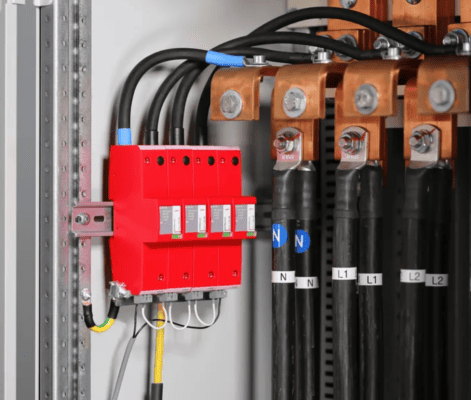
- At the distribution cabinet: Choose a modular Type 2+3 lightning arrester with built-in backup fuses to reduce the impact of sudden overvoltages and spikes.
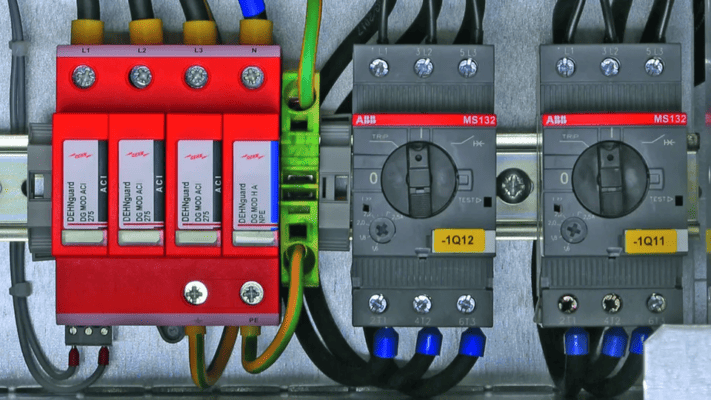
- At the wall charger: You can choose smart chargers equipped with internal surge protection or Type 2+3 surge protection devices installed inside the charging post.
- At the outdoor charging post: Type 2+3 surge protection device with integrated fuse is an optimal choice.
Most charging stations in the world today are equipped with lightning protection devices on the power lines of the charging equipment. However, most investors only install Type 3 equipment to save costs. Experts recommend that for outdoor charging stations, especially without roofs, SPD Type 1 and 2 should be given priority.
Earthing / Grounding System
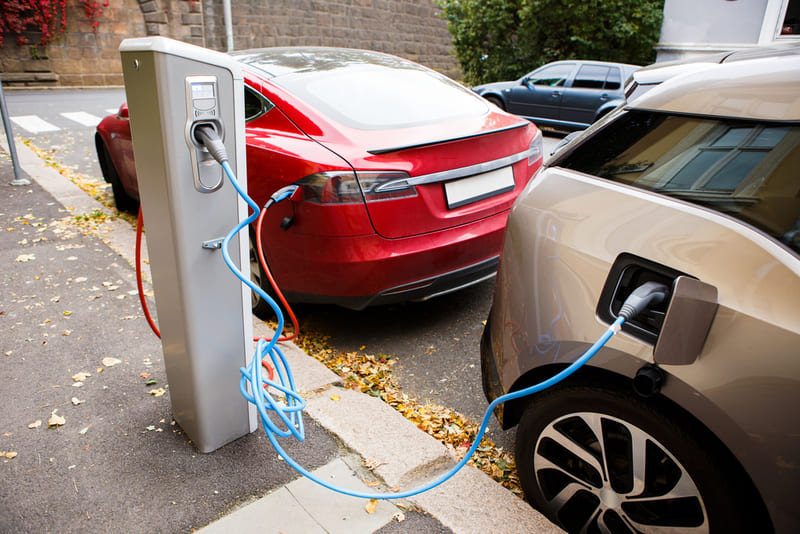
Compared to conventional grounding systems, grounding for charging stations must meet strict and strict requirements, including:
- Equipotential link: The charging station grounding must not be installed separately but must be connected to all other grounding systems present in the area.
- Ensure lowest ground resistance: Grounding resistance should be kept at the lowest level, usually ≤4Ω for surge protection and ≤10Ω for direct lightning protection.
- Step voltage handling: Use equipotential belts or a large grounding network around the charging station to level the ground potential.
Some other protections
- Overvoltage protection: Equipped with high-quality switching devices to protect the charging station and electric vehicle systems against overvoltage, voltage spikes…
- Leakage circuit breaker: Prioritize the use of specialized Type B or Type EV anti-shock protection devices for charging stations.
- Emergency stop button: Allows the operator to immediately turn off the power in case of an emergency such as a fire or explosion at the charging station.
Frequently asked questions about lightning protection for electric vehicle charging stations
Question 1: Does the EV charger have surge protection?
Reply: Have. Some high-end charging models have built-in lightning protection features. However, if we compare the IEC lightning protection standards for charging stations, this level of protection is not suitable and requires an additional SPD installed externally.
Question 2: Where should a surge protector be installed for an EV charger?
Reply: SPD surge protectors for electric vehicle chargers should be installed in the main electrical panel/main distribution panel or input line to the charger.
Question 3: Does home AC charging need to be equipped with a lightning protection device?
Reply: Have. AC charging at home involves daily electricity. Equipping an additional type 1 or 2 SPD device at the main electrical panel will help better protect the building’s electrical system against the effects of lightning.


Nội dung được phát triển bởi đội ngũ truonglehongphong.edu.vn với mục đích chia sẻ và tăng trải nghiệm khách hàng. Mọi ý kiến đóng góp xin vui lòng liên hệ tổng đài chăm sóc: 1900 0000 hoặc email: hotro@truonglehongphong.edu.vn